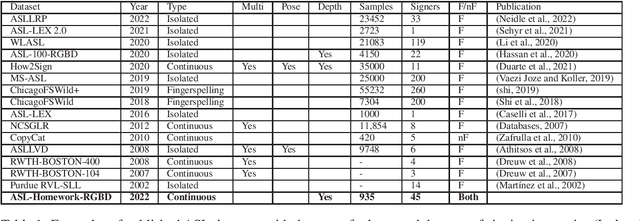Larwan Berke
ASL-Homework-RGBD Dataset: An annotated dataset of 45 fluent and non-fluent signers performing American Sign Language homeworks
Jul 08, 2022
Abstract:We are releasing a dataset containing videos of both fluent and non-fluent signers using American Sign Language (ASL), which were collected using a Kinect v2 sensor. This dataset was collected as a part of a project to develop and evaluate computer vision algorithms to support new technologies for automatic detection of ASL fluency attributes. A total of 45 fluent and non-fluent participants were asked to perform signing homework assignments that are similar to the assignments used in introductory or intermediate level ASL courses. The data is annotated to identify several aspects of signing including grammatical features and non-manual markers. Sign language recognition is currently very data-driven and this dataset can support the design of recognition technologies, especially technologies that can benefit ASL learners. This dataset might also be interesting to ASL education researchers who want to contrast fluent and non-fluent signing.
Sign Language Recognition, Generation, and Translation: An Interdisciplinary Perspective
Aug 22, 2019

Abstract:Developing successful sign language recognition, generation, and translation systems requires expertise in a wide range of fields, including computer vision, computer graphics, natural language processing, human-computer interaction, linguistics, and Deaf culture. Despite the need for deep interdisciplinary knowledge, existing research occurs in separate disciplinary silos, and tackles separate portions of the sign language processing pipeline. This leads to three key questions: 1) What does an interdisciplinary view of the current landscape reveal? 2) What are the biggest challenges facing the field? and 3) What are the calls to action for people working in the field? To help answer these questions, we brought together a diverse group of experts for a two-day workshop. This paper presents the results of that interdisciplinary workshop, providing key background that is often overlooked by computer scientists, a review of the state-of-the-art, a set of pressing challenges, and a call to action for the research community.
 Add to Chrome
Add to Chrome Add to Firefox
Add to Firefox Add to Edge
Add to Edge